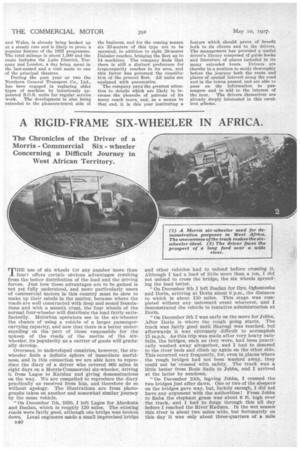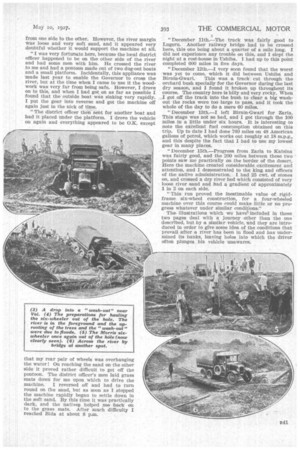A RIGID-FRAME SIX-WHEELER IN AFRICA.
Page 66

Page 67

If you've noticed an error in this article please click here to report it so we can fix it.
The Chronicles of the Driver of a Morris Commercial Six wheeler Concerning a Difficult Journey in West African Territory.
TEE use of six wheels (or any number more than four) offers certain obvious advantages resulting from the better distrilnition of the load and the driving forces. Just how those advantages are to be gained is not yet fully understood, and more particularly users of commercial motors in this country must be slow to make up their minds in the matter, because where the roads are well constructed with deep and sound foundations and with a smooth crust, the four wheels of the normal four-wheeler will distribute the load fairly satisfactorily. Motorbus operators see in the six-wheeler the chance of using a vehicle of a larger passengercarrying capacity, and now that there is a better understanding on the part of those responsible for the upkeep of the roads of the merits of the sixwheeler, its popularity as a carrier of goods will gradually develop.
Overseas, in undeveloped countries, however, the sixwheeler finds a definite sphere of immediate usefulness, and in this connection we are able here to reproduce the diary of a driver who covered 960 mites in eight days on a Morris-Commercial six-wheeler, driving it from Lagos to Katsina and giving demonstrations on the way. We are compelled to reproduce the diary practically as received from him, and therefore do so without apology. The illustrations are from photographs taken on another and somewhat similar journey by the same vehicle.
"On December 7th, 1926, I left Lagos for Abcokuta and Ibadan, which is roughly 120 miles. The existing roads were fairly good, although one bridge was broken down. Local engineers made a Small improvised bridge n40 and other vehicles had to unload before crossing it. Although I had a load of little more than a ton, I did not unload to cross the bridge, the six wheels spreading the load better.
"On December 8th J left Madan for Oyo, Ogbotnosho and florin, arriving at Ilorin about 6 p.m., the distance to which is about 150 miles. This stage was completed without any untoward event whatever, and I demonstrated the vehicle to tentative administration at Darin.
"On December 9th I was early on the move for Jebba. After florin is where the rough going starts. The track was fairly good until Sharagi was reached, but afterwards it was extremely difficult to accomplish 15 m.p.h. As this trip was made after very heavy rainfalls, the bridges, such as they were, had been practically washed away altogether, and I had to descend to the river beds and climb up again on the other side. This occurred very frequently, for, even in places where the rough bridges had not been washed away, they could not be crossed with safety. The track was a little better from Bode Sadu to Jebba, and I arrived at the latter by sundown.
"On December 10th, leaving Jebba, I crossed the two bridges just after dawn. One or two of the sleepers on the bridges gave way, but, luckily enough, I did not have any argument with the authorities! From Jebba to Raba the elephant grass was about 6 ft. high over the track, and I had to forge through this all day before I reached the River Kaduna. In the wet season this river is about two miles wide, but fortunately on this day it was only about three-quarters of a mile from one side to the other. However, the river margin was loose and very soft sand, and it appeared very doubtful whether it would support the machine at all.
"I was very fortunate here, because the local district officer happened to be on the other side of the river and had some men with him. He crossed the river to me and had a pontoon made out of two dug-out boats and a small platform. Incidentally, this appliance was made last year to enable the Governor to cross the river, but at the time when I came to use it the woodwork was very far from being safe. However, I drove on to this, and when I had got on as far as possible I found that the outside boat was sinking very rapidly. I put the gear into reverse and got the machine off again just in the nick of time.
"The district officer then sent for another boat and had it placed under the platform. I drove the vehicle on again and everything appeared to be O.K. except that my rear pair of wheels was overhanging the water! On reaching the sand on the other side it proved rather difficult to get off the pontoon. The district officer's men laid grass mats down for me upon which to drive the machine. I reversed off and had to turn round on the sand, but as soon as I stopped the machine rapidly began to settle down in the soft sand. By this time it was practically dark, and the native,s helped !me back on to the grass mats. After much difficulty I reached Bida at about 8 pan. "December 11th.—The track was fairly good to Lugeru. Another railway bridge had to be crossed here, this one being about a quarter of a mile long. I did not experience any trouble on this, and I slept the night-at a rest-house in Ushiba.. I had up to this point completed 600 miles in five days.
"December 12th.—I very soon found that the worst was yet to come, which it did between Ushiba and Birnin-Gwari. This was a track cut through the orchard bush specially for the Governor during the last dry season, and I found it broken up throughout its course. The country here Is hilly and very rocky. When I got off the track into the bush to clear a big washout the rocks were too large to pass, and it took the whole of the day to do a mere 60 miles.
"December 13th.—I left Birnin-Gwari for Zaria. This stage was not so bad, and I got through the 100 miles in a little under six hours. It is interesting to note the excellent fuel consumption obtained on this trip. Up to date I had done 760 miles on 48 American gallons of petrol, which works out roughly at 18 m.p.g., and this despite the fact that I had to use my lowest gear in many places.
• "December 15th.—Progress from Zaria to Katsina was fairly good, and the 200 miles between these two points saw me practically on the border of the desert. Here the machine created considerable excitement and attention, and I demonstrated to the king and officers of the native administration. I had 25 cwt. of stones on, and crossed a dry river bed which consisted of very loose river sand and had a gradient of approximately 1 in 2 on each side.
"This run proved the inestimable value of rigidframe six-wheel construction, for a four-wheeled machine over this course could make little or no progress whatever under similar conditions." The. illustrations which we have‘ included in these two pages deal with a journey other than the one described, but by a similar vehicle, and they are introduced in order to give some idea of the conditions that prevail after a river has been in flood and has undermined its hanks, leaving holes into which the driver often plunges his vehicle unawares.




















































































































